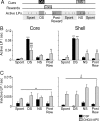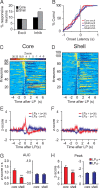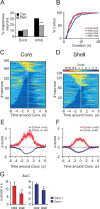Roles of nucleus accumbens core and shell in incentive-cue responding and behavioral inhibition
- PMID: 21543612
- PMCID: PMC3145462
- DOI: 10.1523/JNEUROSCI.6491-10.2011
Roles of nucleus accumbens core and shell in incentive-cue responding and behavioral inhibition
Abstract
The nucleus accumbens (NAc) is involved in many reward-related behaviors. The NAc has two major components, the core and the shell. These two areas have different inputs and outputs, suggesting that they contribute differentially to goal-directed behaviors. Using a discriminative stimulus (DS) task in rats and inactivating the NAc by blocking excitatory inputs with glutamate antagonists, we dissociated core and shell contributions to task performance. NAc core but not shell inactivation decreased responding to a reward-predictive cue. In contrast, inactivation of either subregion induced a general behavioral disinhibition. This reveals that the NAc actively suppresses actions inappropriate to the DS task. Importantly, selective inactivation of the shell but not core significantly increased responding to the nonrewarded cue. To determine whether the different contributions of the NAc core and shell depend on the information encoded in their constituent neurons, we performed electrophysiological recording in rats performing the DS task. Although there was no firing pattern unique to either core or shell, the reward-predictive cue elicited more frequent and larger magnitude responses in the NAc core than in the shell. Conversely, more NAc shell neurons selectively responded to the nonrewarded stimulus. These quantitative differences might account for the different behavioral patterns that require either core or shell. Neurons with similar firing patterns could also have different effects on behavior due to their distinct projection targets.
Figures









Similar articles
-
Nucleus Accumbens Core and Shell Differentially Encode Reward-Associated Cues after Reinforcer Devaluation.J Neurosci. 2016 Jan 27;36(4):1128-39. doi: 10.1523/JNEUROSCI.2976-15.2016. J Neurosci. 2016. PMID: 26818502 Free PMC article.
-
The ventral tegmental area is required for the behavioral and nucleus accumbens neuronal firing responses to incentive cues.J Neurosci. 2004 Mar 24;24(12):2923-33. doi: 10.1523/JNEUROSCI.5282-03.2004. J Neurosci. 2004. PMID: 15044531 Free PMC article.
-
Opposing roles for the nucleus accumbens core and shell in cue-induced reinstatement of food-seeking behavior.Neuroscience. 2008 Jun 26;154(3):877-84. doi: 10.1016/j.neuroscience.2008.04.004. Epub 2008 Apr 9. Neuroscience. 2008. PMID: 18479836
-
Cortico-Striatal Control over Adaptive Goal-Directed Responding Elicited by Cues Signaling Sucrose Reward or Punishment.J Neurosci. 2022 May 4;42(18):3811-3822. doi: 10.1523/JNEUROSCI.2175-21.2022. Epub 2022 Mar 29. J Neurosci. 2022. PMID: 35351827 Free PMC article.
-
Why did I eat that? Contributions of individual differences in incentive motivation and nucleus accumbens plasticity to obesity.Physiol Behav. 2020 Dec 1;227:113114. doi: 10.1016/j.physbeh.2020.113114. Epub 2020 Aug 7. Physiol Behav. 2020. PMID: 32777311 Free PMC article. Review.
Cited by
-
Neural Activity in the Ventral Pallidum Encodes Variation in the Incentive Value of a Reward Cue.J Neurosci. 2016 Jul 27;36(30):7957-70. doi: 10.1523/JNEUROSCI.0736-16.2016. J Neurosci. 2016. PMID: 27466340 Free PMC article.
-
The Nucleus Accumbens Core Is Necessary for Responding to Incentive But Not Instructive Stimuli.J Neurosci. 2020 Feb 5;40(6):1332-1343. doi: 10.1523/JNEUROSCI.0194-19.2019. Epub 2019 Dec 20. J Neurosci. 2020. PMID: 31862857 Free PMC article.
-
Distinct role of nucleus accumbens D2-MSN projections to ventral pallidum in different phases of motivated behavior.Cell Rep. 2022 Feb 15;38(7):110380. doi: 10.1016/j.celrep.2022.110380. Cell Rep. 2022. PMID: 35172164 Free PMC article.
-
Dissociable roles for the ventral and dorsal medial prefrontal cortex in cue-guided risk/reward decision making.Neuropsychopharmacology. 2020 Mar;45(4):683-693. doi: 10.1038/s41386-019-0557-7. Epub 2019 Oct 25. Neuropsychopharmacology. 2020. PMID: 31652433 Free PMC article.
-
Nucleus Accumbens Shell Neurons Encode the Kinematics of Reward Approach Locomotion.Neuroscience. 2023 Aug 1;524:181-196. doi: 10.1016/j.neuroscience.2023.06.002. Epub 2023 Jun 15. Neuroscience. 2023. PMID: 37330195 Free PMC article.
References
-
- Bowman EM, Aigner TG, Richmond BJ. Neural signals in the monkey ventral striatum related to motivation for juice and cocaine rewards. J Neurophysiol. 1996;75:1061–1073. - PubMed
-
- Cardinal RN, Parkinson JA, Hall J, Everitt BJ. Emotion and motivation: the role of the amygdala, ventral striatum, and prefrontal cortex. Neurosci Biobehav Rev. 2002;26:321–352. - PubMed
-
- Cromwell HC, Schultz W. Effects of expectations for different reward magnitudes on neuronal activity in primate striatum. J Neurophysiol. 2003;89:2823–2838. - PubMed
Publication types
MeSH terms
Substances
Grants and funding
LinkOut - more resources
Full Text Sources
